学习链接operator实战
更新中未完
关于k8s常用lib库项目介绍
client-go
client-go项目概览
4种client的类型以及区别可以看这里client
client-go子项目主要是golang语言链接k8s服务端的客户端库,以及k8s中各种内部存储的实现的封装.
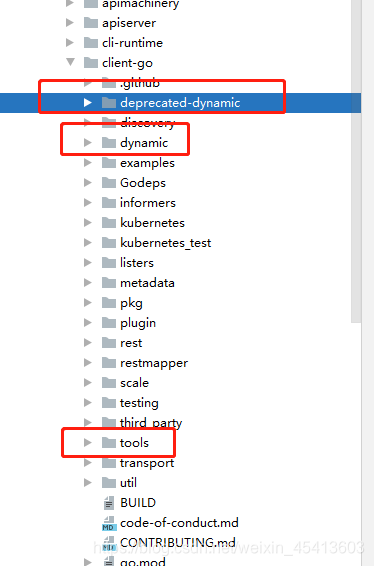
相对比较核心的是dynameic和tools的cache
(1)dynameic
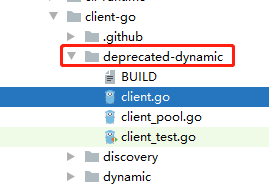
path :\kubernetes\staging\src\k8s.io\client-go\deprecated-dynamic
type Interface interface {
// Resource returns an API interface to the specified resource for this client's
// group and version. If resource is not a namespaced resource, then namespace
// is ignored. The ResourceInterface inherits the parameter codec of this client.
Resource(resource *metav1.APIResource, namespace string) ResourceInterface
}
// ResourceInterface is an API interface to a specific resource under a
// dynamic client.
//针对某种资源做操作
//通过runtime.Object 可以和Unstructured 进行转换
type ResourceInterface interface {
// List returns a list of objects for this resource.
List(opts metav1.ListOptions) (runtime.Object, error)
// Get gets the resource with the specified name.
Get(name string, opts metav1.GetOptions) (*unstructured.Unstructured, error)
// Delete deletes the resource with the specified name.
Delete(name string, opts *metav1.DeleteOptions) error
// DeleteCollection deletes a collection of objects.
DeleteCollection(deleteOptions *metav1.DeleteOptions, listOptions metav1.ListOptions) error
// Create creates the provided resource.
Create(obj *unstructured.Unstructured) (*unstructured.Unstructured, error)
// Update updates the provided resource.
Update(obj *unstructured.Unstructured) (*unstructured.Unstructured, error)
// Watch returns a watch.Interface that watches the resource.
Watch(opts metav1.ListOptions) (watch.Interface, error)
// Patch patches the provided resource.
Patch(name string, pt types.PatchType, data []byte) (*unstructured.Unstructured, error)
}
//有一个client
type Client struct {
version schema.GroupVersion
delegate dynamic.Interface
}
//那么他会拼接一个req 请求
//类似于api/xxx.com/v1/pod 发送到api
type GroupVersion struct {
Group string
Version string
}
// NewClient returns a new client based on the passed in config. The
// codec is ignored, as the dynamic client uses it's own codec.
//那么就会有一个工厂方法创建一个
func NewClient(conf *restclient.Config, version schema.GroupVersion) (*Client, error) {
delegate, err := dynamic.NewForConfig(conf)
if err != nil {
return nil, err
}
return &Client{version: version, delegate: delegate}, nil
}
type Unstructured struct {
// Object is a JSON compatible map with string, float, int, bool, []interface{}, or
// map[string]interface{}
// children.
Object map[string]interface{}
}
delegate.Interface定义在
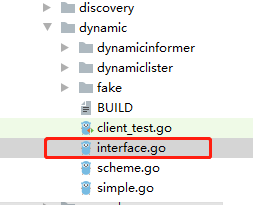
//Unstructured 可以转换为任意一种api的资源版本 例如pod deployment sts等等
type Interface interface {
Resource(resource schema.GroupVersionResource) NamespaceableResourceInterface
}
type ResourceInterface interface {
Create(obj *unstructured.Unstructured, options metav1.CreateOptions, subresources ...string) (*unstructured.Unstructured, error)
Update(obj *unstructured.Unstructured, options metav1.UpdateOptions, subresources ...string) (*unstructured.Unstructured, error)
//updatestatus 这个我们再调用的时候一般不会生效 这个是Controller 等api组件会去调用 我们写operator的时候会用这个 实现某种特定的功能
UpdateStatus(obj *unstructured.Unstructured, options metav1.UpdateOptions) (*unstructured.Unstructured, error)
Delete(name string, options *metav1.DeleteOptions, subresources ...string) error
DeleteCollection(options *metav1.DeleteOptions, listOptions metav1.ListOptions) error
Get(name string, options metav1.GetOptions, subresources ...string) (*unstructured.Unstructured, error)
List(opts metav1.ListOptions) (*unstructured.UnstructuredList, error)
Watch(opts metav1.ListOptions) (watch.Interface, error)
Patch(name string, pt types.PatchType, data []byte, options metav1.PatchOptions, subresources ...string) (*unstructured.Unstructured, error)
}

这里的client连接池需要注意一下,这里的pool就比如我们创建dynamic client 那么比如创建zabbix dynamic client 那么我们只有一个client 如果有连接池我们可以添加多个client 比如 mariadb zabbix 等等client
//我们在clients 中传入groupversion 那么就可以拿到他的client
type clientPoolImpl struct {
lock sync.RWMutex
config *restclient.Config
clients map[schema.GroupVersion]*Client
apiPathResolverFunc APIPathResolverFunc
mapper meta.RESTMapper
}

scheme是一个非常重要的,api启动话注册scheme那么我们服务端为什么还要加载scheme呢?
scheme里面放的是一些group version 等
那是因为当我们比如要获取一个pod的列表 那么我们通过req请求api-server的对应healder 那么返回的response 中是一个json或者yaml的串 我们客户端这边要做解析的话 如果我们有对应的scheme那么会非常好序列化,把这个串根据scheme的信息我们序列化为我们需要得到的信息
//我们再调用的时候就会触发init 会初始化
var watchScheme = runtime.NewScheme()
var basicScheme = runtime.NewScheme()
var deleteScheme = runtime.NewScheme()
var parameterScheme = runtime.NewScheme()
var deleteOptionsCodec = serializer.NewCodecFactory(deleteScheme)
var dynamicParameterCodec = runtime.NewParameterCodec(parameterScheme)
var versionV1 = schema.GroupVersion{Version: "v1"}
func init() {
//针对某个版本v1版本的groupversion 我们把它加入到watchscheme中去
//也就是把某个版本的某种资源加入到全局的scheme中去
metav1.AddToGroupVersion(watchScheme, versionV1)
metav1.AddToGroupVersion(basicScheme, versionV1)
metav1.AddToGroupVersion(parameterScheme, versionV1)
metav1.AddToGroupVersion(deleteScheme, versionV1)
}
func AddToGroupVersion(scheme *runtime.Scheme, groupVersion schema.GroupVersion) {
scheme.AddKnownTypeWithName(groupVersion.WithKind(WatchEventKind), &WatchEvent{})
scheme.AddKnownTypeWithName(
schema.GroupVersion{Group: groupVersion.Group, Version: runtime.APIVersionInternal}.WithKind(WatchEventKind),
&InternalEvent{},
)
// Supports legacy code paths, most callers should use metav1.ParameterCodec for now
scheme.AddKnownTypes(groupVersion,
&ListOptions{},
&ExportOptions{},
&GetOptions{},
&DeleteOptions{},
&CreateOptions{},
&UpdateOptions{},
&PatchOptions{},
)
utilruntime.Must(scheme.AddConversionFuncs(
Convert_v1_WatchEvent_To_watch_Event,
Convert_v1_InternalEvent_To_v1_WatchEvent,
Convert_watch_Event_To_v1_WatchEvent,
Convert_v1_WatchEvent_To_v1_InternalEvent,
))
// Register Unversioned types under their own special group
scheme.AddUnversionedTypes(Unversioned,
&Status{},
&APIVersions{},
&APIGroupList{},
&APIGroup{},
&APIResourceList{},
)
// register manually. This usually goes through the SchemeBuilder, which we cannot use here.
utilruntime.Must(AddConversionFuncs(scheme))
utilruntime.Must(RegisterDefaults(scheme))
}
//以及一些序列化的 以及一些支持的类型这里代码省略了部分可以拉源码看
func (s basicNegotiatedSerializer) SupportedMediaTypes() []runtime.SerializerInfo {
return []runtime.SerializerInfo{
{
MediaType: "application/json",
MediaTypeType: "application",
MediaTypeSubType: "json",
EncodesAsText: true,
Serializer: json.NewSerializer(json.DefaultMetaFactory, basicScheme, basicScheme, false),
PrettySerializer: json.NewSerializer(json.DefaultMetaFactory, basicScheme, basicScheme, true),
StreamSerializer: &runtime.StreamSerializerInfo{
EncodesAsText: true,
Serializer: json.NewSerializer(json.DefaultMetaFactory, basicScheme, basicScheme, false),
Framer: json.Framer,
},
},
}
}

fake这里是有一些样例 方便我们去理解
informer可以理解为是一个Controller 会有一部分逻辑处理 lister就是controller的一部分
lister
type Lister interface {
// List lists all resources in the indexer.
//通过标签选择器 去查询资源 但是资源我们不知道我们需要通过Unstructured 做转换
List(selector labels.Selector) (ret []*unstructured.Unstructured, err error)
// Get retrieves a resource from the indexer with the given name
//根据名字查某一个
Get(name string) (*unstructured.Unstructured, error)
// Namespace returns an object that can list and get resources in a given namespace.
//通过namespace查到 k8s资源分为ns资源跟集群资源 这里是根据ns
Namespace(namespace string) NamespaceLister
}
// NamespaceLister helps list and get resources.
type NamespaceLister interface {
// List lists all resources in the indexer for a given namespace.
List(selector labels.Selector) (ret []*unstructured.Unstructured, err error)
// Get retrieves a resource from the indexer for a given namespace and name.
Get(name string) (*unstructured.Unstructured, error)
}
// List lists all resources in the indexer.
//可以理解为如果我们要通过ns的话我们还要调用namespance例如pod 如果是集群资源例如node list足够
func (l *dynamicLister) List(selector labels.Selector) (ret []*unstructured.Unstructured, err error) {
err = cache.ListAll(l.indexer, selector, func(m interface{}) {
ret = append(ret, m.(*unstructured.Unstructured))
})
return ret, err
}
func (l *dynamicLister) Namespace(namespace string) NamespaceLister {
return &dynamicNamespaceLister{indexer: l.indexer, namespace: namespace, gvr: l.gvr}
}
(2)discovery
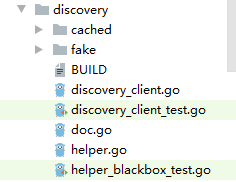
DiscoveryClient是发现客户端,主要用于发现api server支持的资源组 资源版本 资源信息,k8s api server 支持很多资源组 资源版本,资源信息,此时可以通过DiscoveryClient来查看
type DiscoveryInterface interface {
RESTClient() restclient.Interface
ServerGroupsInterface
ServerResourcesInterface
ServerVersionInterface
OpenAPISchemaInterface
}
(3)kubernetes

k8s所有fake下面都是 类似于写了一个样例 来帮助我们 理解阅读
clientset这里就是一些接口的封装,包含了所有k8s版本化的一些封装
scheme就是把这些注册进去
typed就是具体的某个资源版本的封装
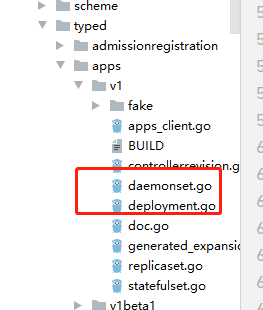
type Interface interface {
Discovery() discovery.DiscoveryInterface
AdmissionregistrationV1() admissionregistrationv1.AdmissionregistrationV1Interface
AdmissionregistrationV1beta1() admissionregistrationv1beta1.AdmissionregistrationV1beta1Interface
AppsV1() appsv1.AppsV1Interface
AppsV1beta1() appsv1beta1.AppsV1beta1Interface
AppsV1beta2() appsv1beta2.AppsV1beta2Interface
AuditregistrationV1alpha1() auditregistrationv1alpha1.AuditregistrationV1alpha1Interface
AuthenticationV1() authenticationv1.AuthenticationV1Interface
AuthenticationV1beta1() authenticationv1beta1.AuthenticationV1beta1Interface
AuthorizationV1() authorizationv1.AuthorizationV1Interface
AuthorizationV1beta1() authorizationv1beta1.AuthorizationV1beta1Interface
AutoscalingV1() autoscalingv1.AutoscalingV1Interface
AutoscalingV2beta1() autoscalingv2beta1.AutoscalingV2beta1Interface
AutoscalingV2beta2() autoscalingv2beta2.AutoscalingV2beta2Interface
BatchV1() batchv1.BatchV1Interface
BatchV1beta1() batchv1beta1.BatchV1beta1Interface
BatchV2alpha1() batchv2alpha1.BatchV2alpha1Interface
CertificatesV1beta1() certificatesv1beta1.CertificatesV1beta1Interface
CoordinationV1beta1() coordinationv1beta1.CoordinationV1beta1Interface
CoordinationV1() coordinationv1.CoordinationV1Interface
CoreV1() corev1.CoreV1Interface
DiscoveryV1alpha1() discoveryv1alpha1.DiscoveryV1alpha1Interface
EventsV1beta1() eventsv1beta1.EventsV1beta1Interface
ExtensionsV1beta1() extensionsv1beta1.ExtensionsV1beta1Interface
NetworkingV1() networkingv1.NetworkingV1Interface
NetworkingV1beta1() networkingv1beta1.NetworkingV1beta1Interface
NodeV1alpha1() nodev1alpha1.NodeV1alpha1Interface
NodeV1beta1() nodev1beta1.NodeV1beta1Interface
PolicyV1beta1() policyv1beta1.PolicyV1beta1Interface
RbacV1() rbacv1.RbacV1Interface
RbacV1beta1() rbacv1beta1.RbacV1beta1Interface
RbacV1alpha1() rbacv1alpha1.RbacV1alpha1Interface
SchedulingV1alpha1() schedulingv1alpha1.SchedulingV1alpha1Interface
SchedulingV1beta1() schedulingv1beta1.SchedulingV1beta1Interface
SchedulingV1() schedulingv1.SchedulingV1Interface
SettingsV1alpha1() settingsv1alpha1.SettingsV1alpha1Interface
StorageV1beta1() storagev1beta1.StorageV1beta1Interface
StorageV1() storagev1.StorageV1Interface
StorageV1alpha1() storagev1alpha1.StorageV1alpha1Interface
}
// Clientset contains the clients for groups. Each group has exactly one
// version included in a Clientset.
type Clientset struct {
*discovery.DiscoveryClient
admissionregistrationV1 *admissionregistrationv1.AdmissionregistrationV1Client
admissionregistrationV1beta1 *admissionregistrationv1beta1.AdmissionregistrationV1beta1Client
appsV1 *appsv1.AppsV1Client
appsV1beta1 *appsv1beta1.AppsV1beta1Client
appsV1beta2 *appsv1beta2.AppsV1beta2Client
auditregistrationV1alpha1 *auditregistrationv1alpha1.AuditregistrationV1alpha1Client
authenticationV1 *authenticationv1.AuthenticationV1Client
authenticationV1beta1 *authenticationv1beta1.AuthenticationV1beta1Client
authorizationV1 *authorizationv1.AuthorizationV1Client
authorizationV1beta1 *authorizationv1beta1.AuthorizationV1beta1Client
autoscalingV1 *autoscalingv1.AutoscalingV1Client
autoscalingV2beta1 *autoscalingv2beta1.AutoscalingV2beta1Client
autoscalingV2beta2 *autoscalingv2beta2.AutoscalingV2beta2Client
batchV1 *batchv1.BatchV1Client
batchV1beta1 *batchv1beta1.BatchV1beta1Client
batchV2alpha1 *batchv2alpha1.BatchV2alpha1Client
certificatesV1beta1 *certificatesv1beta1.CertificatesV1beta1Client
coordinationV1beta1 *coordinationv1beta1.CoordinationV1beta1Client
coordinationV1 *coordinationv1.CoordinationV1Client
coreV1 *corev1.CoreV1Client
discoveryV1alpha1 *discoveryv1alpha1.DiscoveryV1alpha1Client
eventsV1beta1 *eventsv1beta1.EventsV1beta1Client
extensionsV1beta1 *extensionsv1beta1.ExtensionsV1beta1Client
networkingV1 *networkingv1.NetworkingV1Client
networkingV1beta1 *networkingv1beta1.NetworkingV1beta1Client
nodeV1alpha1 *nodev1alpha1.NodeV1alpha1Client
nodeV1beta1 *nodev1beta1.NodeV1beta1Client
policyV1beta1 *policyv1beta1.PolicyV1beta1Client
rbacV1 *rbacv1.RbacV1Client
rbacV1beta1 *rbacv1beta1.RbacV1beta1Client
rbacV1alpha1 *rbacv1alpha1.RbacV1alpha1Client
schedulingV1alpha1 *schedulingv1alpha1.SchedulingV1alpha1Client
schedulingV1beta1 *schedulingv1beta1.SchedulingV1beta1Client
schedulingV1 *schedulingv1.SchedulingV1Client
settingsV1alpha1 *settingsv1alpha1.SettingsV1alpha1Client
storageV1beta1 *storagev1beta1.StorageV1beta1Client
storageV1 *storagev1.StorageV1Client
storageV1alpha1 *storagev1alpha1.StorageV1alpha1Client
}

https://godoc.org/k8s.io/client-go/kubernetes
在godoc我们也可以看到
//例如deployment就提供了这些接口
// DeploymentInterface has methods to work with Deployment resources.
type DeploymentInterface interface {
Create(*v1.Deployment) (*v1.Deployment, error)
Update(*v1.Deployment) (*v1.Deployment, error)
UpdateStatus(*v1.Deployment) (*v1.Deployment, error)
Delete(name string, options *metav1.DeleteOptions) error
DeleteCollection(options *metav1.DeleteOptions, listOptions metav1.ListOptions) error
Get(name string, options metav1.GetOptions) (*v1.Deployment, error)
List(opts metav1.ListOptions) (*v1.DeploymentList, error)
Watch(opts metav1.ListOptions) (watch.Interface, error)
Patch(name string, pt types.PatchType, data []byte, subresources ...string) (result *v1.Deployment, err error)
GetScale(deploymentName string, options metav1.GetOptions) (*autoscalingv1.Scale, error)
UpdateScale(deploymentName string, scale *autoscalingv1.Scale) (*autoscalingv1.Scale, error)
//至于DeploymentExpansion 是为了方便我们二开假如我们要实现一个client 那么就可以在这个里面加
DeploymentExpansion
}


证书这块主要是为了 当我们创建pod的时候会发现在/var/run/xxxxx会挂在一些证书的相关星系,会用这种方式去请求
(4)listers
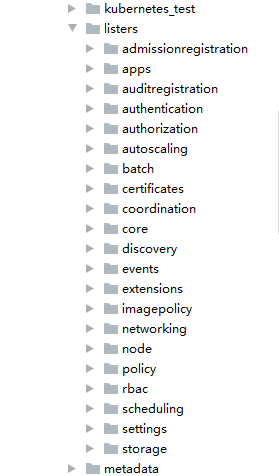
是所有资源版本的一些lister的实现

type DeploymentLister interface {
// List lists all Deployments in the indexer.
//list
List(selector labels.Selector) (ret []*v1.Deployment, err error)
//对应的ns的list
// Deployments returns an object that can list and get Deployments.
Deployments(namespace string) DeploymentNamespaceLister
DeploymentListerExpansion
}
(5)pkg

version定义了一些版本信息
(6)plugin

定义了认证相关 的东西
(7)rest
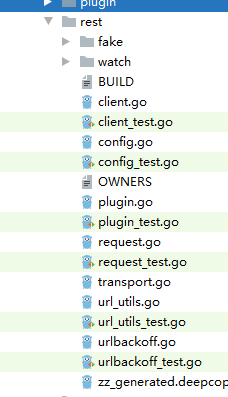
这里定义了最底层的client封装
config 这里定义了api的一写信息包括host user等等
type Config struct {
// Host must be a host string, a host:port pair, or a URL to the base of the apiserver.
// If a URL is given then the (optional) Path of that URL represents a prefix that must
// be appended to all request URIs used to access the apiserver. This allows a frontend
// proxy to easily relocate all of the apiserver endpoints.
Host string
// APIPath is a sub-path that points to an API root.
APIPath string
// ContentConfig contains settings that affect how objects are transformed when
// sent to the server.
ContentConfig
// Server requires Basic authentication
Username string
Password string
// Server requires Bearer authentication. This client will not attempt to use
// refresh tokens for an OAuth2 flow.
// TODO: demonstrate an OAuth2 compatible client.
BearerToken string
// Path to a file containing a BearerToken.
// If set, the contents are periodically read.
// The last successfully read value takes precedence over BearerToken.
BearerTokenFile string
// Impersonate is the configuration that RESTClient will use for impersonation.
Impersonate ImpersonationConfig
// Server requires plugin-specified authentication.
AuthProvider *clientcmdapi.AuthProviderConfig
// Callback to persist config for AuthProvider.
AuthConfigPersister AuthProviderConfigPersister
// Exec-based authentication provider.
ExecProvider *clientcmdapi.ExecConfig
// TLSClientConfig contains settings to enable transport layer security
TLSClientConfig
// UserAgent is an optional field that specifies the caller of this request.
UserAgent string
// DisableCompression bypasses automatic GZip compression requests to the
// server.
DisableCompression bool
// Transport may be used for custom HTTP behavior. This attribute may not
// be specified with the TLS client certificate options. Use WrapTransport
// to provide additional per-server middleware behavior.
Transport http.RoundTripper
// WrapTransport will be invoked for custom HTTP behavior after the underlying
// transport is initialized (either the transport created from TLSClientConfig,
// Transport, or http.DefaultTransport). The config may layer other RoundTrippers
// on top of the returned RoundTripper.
//
// A future release will change this field to an array. Use config.Wrap()
// instead of setting this value directly.
WrapTransport transport.WrapperFunc
// QPS indicates the maximum QPS to the master from this client.
// If it's zero, the created RESTClient will use DefaultQPS: 5
QPS float32
// Maximum burst for throttle.
// If it's zero, the created RESTClient will use DefaultBurst: 10.
Burst int
// Rate limiter for limiting connections to the master from this client. If present overwrites QPS/Burst
RateLimiter flowcontrol.RateLimiter
// The maximum length of time to wait before giving up on a server request. A value of zero means no timeout.
Timeout time.Duration
// Dial specifies the dial function for creating unencrypted TCP connections.
Dial func(ctx context.Context, network, address string) (net.Conn, error)
// Version forces a specific version to be used (if registered)
// Do we need this?
// Version string
}
client
//定义一个接口
type Interface interface {
GetRateLimiter() flowcontrol.RateLimiter
//这里的request就是http的req 那么拿到就可以发http请求
Verb(verb string) *Request
Post() *Request
Put() *Request
Patch(pt types.PatchType) *Request
Get() *Request
Delete() *Request
APIVersion() schema.GroupVersion
}
//接口的实现
type RESTClient struct {
// base is the root URL for all invocations of the client
base *url.URL
// versionedAPIPath is a path segment connecting the base URL to the resource root
versionedAPIPath string
// contentConfig is the information used to communicate with the server.
contentConfig ContentConfig
// serializers contain all serializers for underlying content type.
serializers Serializers
// creates BackoffManager that is passed to requests.
createBackoffMgr func() BackoffManager
// TODO extract this into a wrapper interface via the RESTClient interface in kubectl.
Throttle flowcontrol.RateLimiter
// Set specific behavior of the client. If not set http.DefaultClient will be used.
Client *http.Client
}
//这个主要是做序列化的
type Serializers struct {
Encoder runtime.Encoder
Decoder runtime.Decoder
StreamingSerializer runtime.Serializer
Framer runtime.Framer
RenegotiatedDecoder func(contentType string, params map[string]string) (runtime.Decoder, error)
}
plugin
//认证是插件集成
type AuthProvider interface {
// WrapTransport allows the plugin to create a modified RoundTripper that
// attaches authorization headers (or other info) to requests.
WrapTransport(http.RoundTripper) http.RoundTripper
// Login allows the plugin to initialize its configuration. It must not
// require direct user interaction.
Login() error
}
//发送到api的时候根据插件的名字 调用对应插件的login方法
func RegisterAuthProviderPlugin(name string, plugin Factory) error {
pluginsLock.Lock()
defer pluginsLock.Unlock()
if _, found := plugins[name]; found {
return fmt.Errorf("auth Provider Plugin %q was registered twice", name)
}
klog.V(4).Infof("Registered Auth Provider Plugin %q", name)
plugins[name] = plugin
return nil
}
request就是封装了以西request的方法
transport就是拿到一个连接做一些修改再发一个连接出去 类似于拦截器
url_util 就是对url操作的一些方法的封装
watch是序列化反序列化
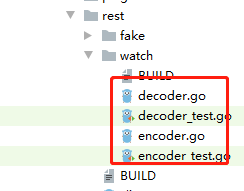
(8)restmapper
// 通过restmapper 传入groupversion 我们可以获取kind以及或者其他的信息
type RESTMapper interface {
// KindFor takes a partial resource and returns the single match. Returns an error if there are multiple matches
KindFor(resource schema.GroupVersionResource) (schema.GroupVersionKind, error)
// KindsFor takes a partial resource and returns the list of potential kinds in priority order
KindsFor(resource schema.GroupVersionResource) ([]schema.GroupVersionKind, error)
// ResourceFor takes a partial resource and returns the single match. Returns an error if there are multiple matches
ResourceFor(input schema.GroupVersionResource) (schema.GroupVersionResource, error)
// ResourcesFor takes a partial resource and returns the list of potential resource in priority order
ResourcesFor(input schema.GroupVersionResource) ([]schema.GroupVersionResource, error)
// RESTMapping identifies a preferred resource mapping for the provided group kind.
RESTMapping(gk schema.GroupKind, versions ...string) (*RESTMapping, error)
// RESTMappings returns all resource mappings for the provided group kind if no
// version search is provided. Otherwise identifies a preferred resource mapping for
// the provided version(s).
RESTMappings(gk schema.GroupKind, versions ...string) ([]*RESTMapping, error)
ResourceSingularizer(resource string) (singular string, err error)
}
(9)scale
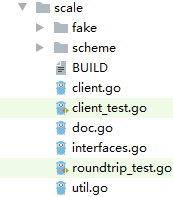
这个就是对一些伸缩的封装
(10)tools
内容太多详情请见tools
(11)其他一些目录简介
transport 安全认证的一些封装
util是一些通用方法
testint就是测试